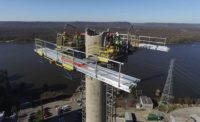With federal approval to build the first U.S. nuclear reactors in 30 years granted on Feb. 9, two units in the state of Georgia set to generate 2,200 MW of power will proceed. However, the nuclear industry sees future growth in a more scaled-down version known as the small modular reactor, or SMR. Firms already are developing SMRs, ranging in size from 45 MW to 300 MW.
"It's time to take the next step, and just about everyone agrees that small reactors are the way forward," says Chris Mowry, president of the Babcock & Wilcox division that is developing, with Bechtel Corp., a small nuclear reactor, called mPower. Several other companies are pushing into the SMR marketplace, too, including NuScale Power, in partnership with Fluor Corp.; Holtec, in partnership with The Shaw Group Inc., and Westinghouse Co. All SMRs are in a preliminary design stage; at the earliest, the first reactor is expected in 2020.
With small-reactor development costs a fraction of the cost of larger reactors, a plant rated at a few hundred megawatts would likely cost about $1 billion to $2 billion, Mowry says. That amount is small enough to secure financing through private capital markets, he adds.
SMRs also could be used to build out a 1,000-plus-MW nuclear powerplant at a more gradual pace. "At the end of the day, that's really the value proposition," Mowry says. He believes the 12 utilities that have applied to the U.S. Nuclear Regulatory Commission for large-reactor licenses, but have not committed to building them, could transfer their investments and work into applications for small reactors.
But not all utilities believe the switch is that simple. "[SMRs] are a long way off from licensing," said William Johnson, president and CEO of Progress Energy Inc. at a Feb. 9 industry briefing. "In addition, is it economic? It's too conceptual now."
A study released on Dec. 1 by the University of Chicago and commissioned by the U.S. Energy Dept. found that electricity from a small nuclear reactor could compete with natural-gas powerplants after 2020 because the units can be built in factories, where mass production would increase efficiency.
To help spur SMR development, DOE in January issued a draft funding opportunity for grants of $452 million over five years to provide licensing and engineering support for up to two SMR designs. Babcock & Wilcox, Nu-Scale and Westinghouse all have said they will apply for funding through the program. Westinghouse, which designed the AP1000 that will be used at Southern Co.'s Vogtle plant in Georgia, said it would apply with a consortium of utilities for funding for its small pressurized-water reactor that has a capacity of 200 MW.
Aris Candris, CEO of Westinghouse, said on Feb. 9 that the company's SMR prototype is based upon the AP1000 design. Developing it would cost $1 billion, he estimates. "The advantage of SMR is that the investment can be piecemeal," said Candris, who is set to retire March 31 but will stay on as a firm adviser. However, he cautioned, "I don't want to be too positive. We have to see the mass production."
Babcock & Wilcox—which has a partner in the Tennessee Valley Authority utility as well as a new Lynchburg, Va., demonstration testing facility—has a good shot at getting one of the federal grants, Mowry says.
However, NuScale has the same expectation. "Ours is a very innovative approach. Each unit is smaller, the design is scalable, and it's underwater and underground," says Bruce Landry, its chief marketing officer. NuScale, which was stalled by funding problems until Fluor invested in the company last October, is not as far along in its design and licensing as Babcock & Wilcox. But, Landry notes, "It's not a question of who is first. It's a question of the quality of the applications."


Post a comment to this article
Report Abusive Comment